Maintaining good humidity (with proper air circulation) is one of the most important parts of cultivating orchids. When grown indoors, orchids need more than our homes can provide. Living rooms usually are around 20% humidity, when most orchids thrive at percentages above 50%.
Indoor humidity is hard to achieve without a humidifier, even if you use a humidity tray. Searching for humidifiers online can be crazy, with so many options and products. Here, I’ll explain what kind of humidifiers are on the market and how to pick the best one for your orchid’s growing needs.
Before you read the article below, please check out the main article on humidity and why it’s important for the health of your orchid. In that article, I go over the basic principles of humidity. It’s a good starting point to understand basic terms and what we want to achieve by buying a humidifier.
Once you’ve read that article, come back to this one, since I’ll be specifying individual products for sale, and not the importance of proper humidity for orchid culture.
Quick Review of Humidity for Orchids
Not all orchids grow in the tropical rain forest. Some have adapted to drier climates, and other to colder climates. Know your orchid before buying a humidifier.
If you have a variety of orchids, then group the species together and focus on providing a specific humidity level to those. Place other orchids in a different spot, and apply more or less humidity depending on the type of orchid.
For a quick overview, orchids are categorized into three specific categories when it comes to humidity.
Low Humidity
Intermediate Humidity
High Humidity
There are a few orchids that like drier climates, which means around 35-40%. These include Dendrobiums, Laelias, and Catesetums.
Most orchids like a little more humidity, around 40 to 50%. These include the most accessibly bought orchids, like Cattleyas, Oncidiums, and Phalaenopsis.
To elaborate this guide, I focused on humidifiers that would satisfy these orchids in the intermediate range, and not orchids in the other two categories.
For indoor growing, we don’t recommend buying orchids in the high humidity category. To provide the humidity requirements for these without the proper insulation and wall preparation, the dry wall, plaster, and window sills will mold. The humidity will penetrate the walls and condense on the exterior siding, causing extensive damage to the structure of your house.
Draculas (or Masdevallias) are in this category, and they prefer around 70-80% of relative humidity. To grow these higher-humidity orchids, you’ll need to either a buy a plastic enclosure and maintain that enclosure ventilated with small circular fans, or build a greenhouse. I made a video about creating a terrarium with Draculas and Masdevalias, which you can see on this page.
A few signs that your orchid is not receiving sufficient humidity is the drying and browning of the tips of the leaves. The very end dries up like crumpled leaves after they fall. The leaves become wrinkled and droopy. On sympodials, the pseudobulbs will start to shrink.
Why do you need a humidifier?
To maintain higher temperatures during the day, especially during winter, you’ll need to keep the heater running. Indoor heating pulls all the relative humidity in the room out, as it heats the air.
This is one reason why we can suffer during winter: dry, cracked skin, itchy and irritated eyes, hair that breaks off easy, and dry throat. Of course, I’m biased here, because after living over 40 years in a tropical country, I now live in the harsh winters of Kansas.
Mind I say, I’m having a hard time adapting, so imagine how much an orchid suffers.
Measuring Humidity in Your Living Room
To measure the humidity in your home office or living room, you can purchase one of two instruments. In time, you’ll know the right humidity levels just by sensing it on your skin, eyes, and nose. But until you get there, either of these two are good to have.
But let me just say that, in my opinion, I wouldn’t invest too much in these. The prices are these can go from less than 10 dollars to around 150. You get what you pay for, so don’t expect a ten dollar one to work the same as the 150 dollar one.
In time, you’ll sense when the humidity is off, so these will be temporary.

The first is a less sophisticated but very accurate apparatus, called a sling psychrometer.
This mechanism is very simple, consisting of two thermometers. On the end of one of the thermometers, you attach a wet cloth. The humidity in the air will cool the wet cloth, bringing the temperature down. To get a quick but accurate reading, you rotate the enclosed thermometer in the air, like a sling.The more the temperature drops, or should I say, the bigger the difference between these two readings, the lower the humidity is in the room.
Most sling psychrometers have scales to compare the differences in temperature, so you can have a good overall idea of the relative humidity in that environment. The cheaper models won’t have scales, so you’ll have to download those online.
If you want to try a more electrical solution, there are hygrometers for sale too.
Hygrometers (most often called humidistats) measure the relative humidity in the air.
Even thought they aren’t as accurate as a sling psychrometer, they are easier to read, analyze, and verify data.
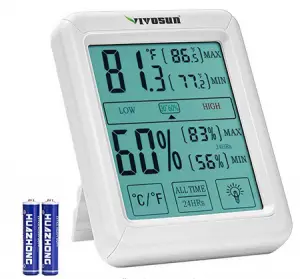
As for me, I prefer an electrical hygrometer. Even knowing that the reading is a bit off, maybe a few numbers, it doesn’t bother me that much. I’m not aiming for an exact number anyway.
I went with the VIVOSUN Digital Indoor Thermometer & Hygrometer (Affiliate Link). This way I also have the temperature settings in the same device. I found it to be relatively inexpensive. When I bought it, the price was less than $US 15.00.
This way I also have the temperature settings in the same device. I found it to be relatively inexpensive. When I bought it, the price was less than $US 15.00.
But before you click on the link and check out the hygrometer, verify some of the humidifiers below. Many have built-in humidifiers (even though the exact preciseness is not going to be on par.)
If you want a general idea of humidity, and are not doing a science experiment, I suggest buying a humidifier with a built-in hygrometer—cheaper in the long run and less clutter.
Once you know what the relative humidity is in your home office, now it’s time to buy a humidifier that will increase those numbers. There are mainly four types of humidifiers:
warm-vapor humidifiers,
cool mist or fog humidifiers,
passive evaporation, and
ultrasonic models.
Let’s take a look at each one below. To put together this article, I read over one thousand reviews, searching in the comments and suggestions what each person who bought it had to say.
I do not own all these models, obviously. But I will include the one I own at the end of the article, since it is what best met my needs. I will say that it is none of the four I list here, and I’ll explain why later. So keep this in mind while reading.
Passive Evaporation Systems for Orchids
This is the cheapest and also less effective way to raise humidity.
Let’s say that after you bought a hygrometer and measured the relative humidity in your environment, all you need is a little more humidity. In this case, I wouldn’t go out and buy a humidifier. You can learn how to make a humidity tray yourself in this article.
The humidity levels with humidity trays will not raise more than 5%. If you spread ten around the same room, you might get closer to 8%.
The idea is to have a small basin of water and add pebbles, covering the water. Place the orchid pot on top of the tray, where the bottom of the pot is not in the water, but above it. If the water is touching the roots or the bottom of the pot, you’ll have problems with root rot and potting medium decay.
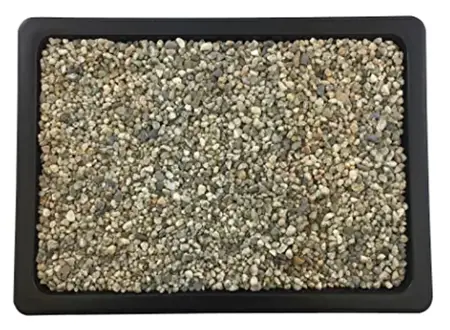
Best review: If you are looking for a more professional look than something you’d make at home, I recommend Drip and Humidity Tray with Washed River Rocks (Affiliate Link) from Bonsai Outlet.
from Bonsai Outlet.
They are incredibly sturdy and maintain their functionality well. The pebbles are included, too.
Warm-Vapor Humidifiers for Orchids
As the name implies, these warm-vapor humidifiers produce a steam vapor by heating the water. The environment will heat up by a few degrees, but they run quietly. The idea is the same behind a boiling pot of water. As the water heats up, it evaporates into the air.
As with boiling water, you’ll be able to see the mist as it comes out of the humidifier.
Some people prefer invisible mist, but warm-vapor does not produce that.
If you have small children (or big clumsy dogs, like I do) then I wouldn’t go for this option.
Even though technology has come a long way, if manipulated the wrong way, accidents could happen. And hot water is never a good combination when it comes to children.
This option does provide the benefit of being healthier, since the water is boiled before being released into the room. Any bacteria that might be in the system dies.
They are quieter, too. No big fans running, just a low gurgitation and bubbling of water, like a boiling sound. I like to compare it to a peaceful, dripping waterfall.
This model will not be able to keep up humidity in larger rooms or big basements. If you are aiming at raising humidity in those huge areas, go for a cooler-mist option below.
The downside to these models is that they use a lot of water. Let me emphasize that: A LOT OF WATER. You have to refill these two or three times a day to work properly. And with lots of water, comes lots of time cleaning.
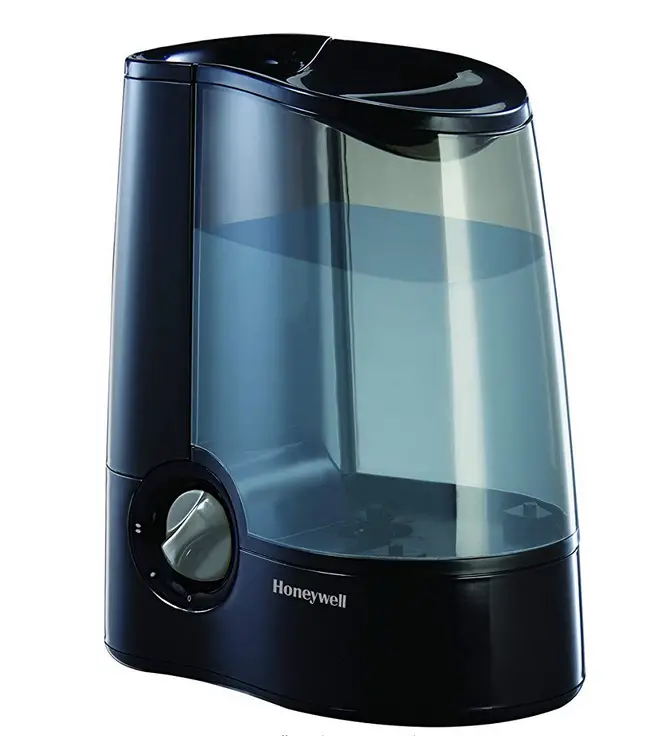
Best option: HONEYWELL Filter Free Warm Mist Humidifier (Affiliate Link.) This one sold me on the brand name. Honeywell does produce excellent products and this humidifier is one of them.
This one sold me on the brand name. Honeywell does produce excellent products and this humidifier is one of them.
The good thing about this particular model is that a light will come on, indicating its time to clean the filters. With only having to fill it once a day, this filter was initially designed to treat respiratory illnesses.
It does come with a medicine tray for that purpose.
Cool-Mist, Evaporative, or Fog Humidifiers for Orchids
This option doesn’t heat up the air in the room, and cool to cold air is pushed out into the environment. Sometimes these are called evaporative models.
How this humidifier works is that an extremely powerful (and loud) fan will blow over the surface of the water, producing water vapor. In other cases, a wick is placed in the water. The fan blows directly on the wick, pushing humid air into the room.
The downside is the noise this fan makes. To produce enough air circulation to produce water vapor, the fan is extremely powerful—and noisy. In fact, during my research, I was swayed to buy this one, but didn’t because of the noise. But I’ll explain that later.
Pros: this is more wallet-friendly, compared to warm-vapor humidifiers, since they don’t need to heat up water. To purchase, they might be the same price, but to run over a long period of time, this model will not run up your electricity bill as much as the other models.
If you get a bigger humidifier, you can keep it running for days without refilling the reservoir. This model is also good for bigger rooms, like large living rooms or basements.
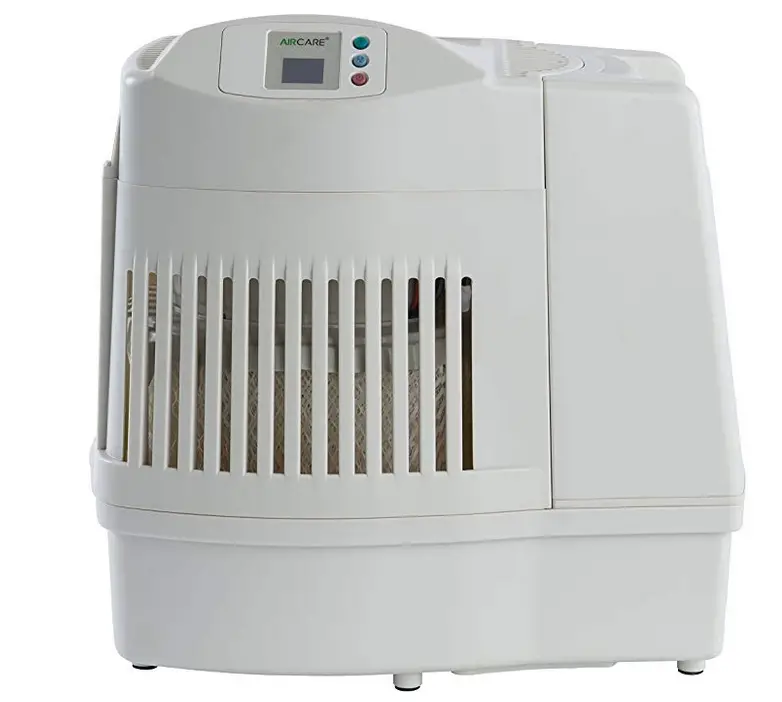
The best ranking evaporative humidifier in our opinion was the AIRCARE MA0800 Digital Whole-House Console-Style Evaporative Humidifier (Affiliate Link). With around 80% of positive reviews, and over 2,800 comments, this humidifier does what it says.
With around 80% of positive reviews, and over 2,800 comments, this humidifier does what it says.
There’s no white powder from this one since the minerals will cling to the wick. That being said, you have to replace the wick regularly, and the price can vary on these from around 5 to 16 dollars, depending where you buy them.Before you buy this, do note that this machine is a big mama. It looks like a mini air-conditioner that sits on the floor. Make sure you have room to properly place it and if you don’t mind the noise, this is your best option.
The price was a bit salty, but it’s worth it.
With the increase of technology, there are some humidifiers that have both the cool and the warm mist models, side by side. The good thing about these, is that during the winter you can use the warm mist and during summer, the cool mist.
If you are wondering what the effect is of either cool air or warm air, the truth is by the time the vapor or mist reaches your orchid, the mist will be the same temperature. The big difference is right as it exits the shoot and the overall temperature in your room after running the humidifier.
Ultrasonic Humidifiers
The last type of humidifier is the Ultrasonic Humidifier. These are the most popular today, despite the waves of ups and downs over the last few decades.
This system works much like the cool fog system, but instead of a fan, the ultrasonic systems use a vibrating or spinning disk to create ultrasonic waves. These disk-type propellers break the water into tiny droplets, much smaller than the fog does.
Over the years, there have been lots of concern over the white, powdery calcium and other minerals that are blown out of the ultrasonic humidifiers. If kept in the same place over a period of time, you’ll see a white, cornstarch-like powder on the top of your furniture.
Many health concerns were raised.
The positive qualities of the humidifier were questioned, but many years after, the ultrasonic humidifiers still rank number one in small environments, like bedrooms and home-offices.
If used without cleaning, these calcium build-ups can settle on the pores of the orchid leaves, clogging them.
If you’re in a home office, like I am, imagine breathing calcium day in and day out. I don’t recommend it.
By any means, if you have a larger room or want to raise the humidity of your basement, even a 6L ultrasonic will not get the job done. You’ll need to install one of the other models.
The ultrasonic humidifier was developed to help people sleep better, by raising the humidity at night. The older models were never intended to be kept on 24 hours a day.
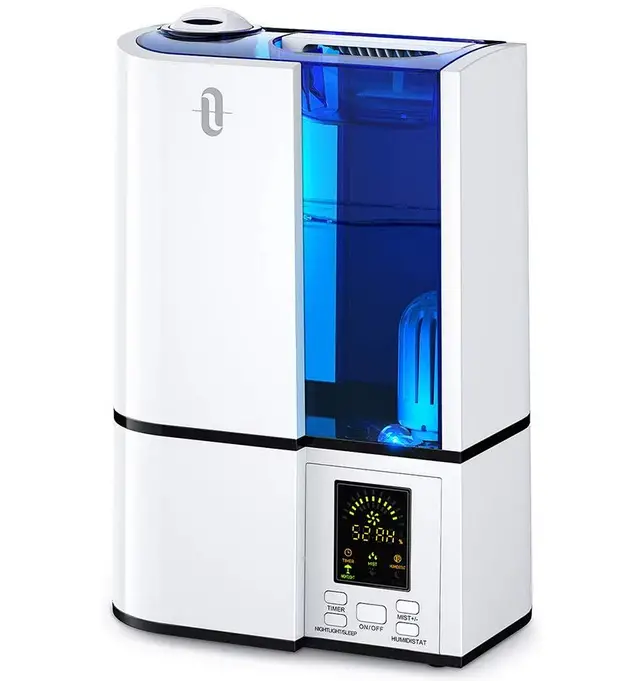
The best ultrasonic humidifier is TaoTronics Cool Mist Humidifier (Affiliate Link).  Even though it does say cool-mist in the name, it is an ultrasonic.
Even though it does say cool-mist in the name, it is an ultrasonic.
It outsells all the other humidifiers by long shots. It also comes with a humidistat. Even though there were reviews that talked about loud air noises, and it leaking everywhere, and some got broken models, these were less than 10% of the more than 2,000 reviews left on Amazon.
The one consistent complaint was that it does not raise humidity in larger rooms like advertised, and the company insisted that it did. But when the complaints are consistently saying the same thing over and over, there’s a hint to that it might be true.
Don’t plan on getting this to humidify the whole house.
Amazon may notify you that there’s a newer model available, but don’t click on that one. It is designed to diffuse essential oils and has close to half the capacity to hold water than this one does. Sometimes, older is better. When I wrote this article, this humidifier was ranking number 4 in the category of overall humidifiers.
The graph below is better seen on a laptop or computer screen, and not by mobile. On smaller screens it rearranges the columns. I’m still working on fixing this… (Sorry!)
| Warm-Mist | Cool-Mist | Ultrasonic | |
| Noise | Boiling Water | Loud Fan | Bubbling |
| Functionality | Water vapor is created at high temperatures | Fan pushes air across a wick | Ultrasonic waves are produced |
| Type of Mist | Visible | Invisible | Visible |
No matter what type of humidifier you choose, these systems need to be cleaned regularly. Bacteria love water–> Fungus love bacteria–> Humidifiers love fungus.
Okay, so that’s not exactly how it works, but that’s what it seems like.
If your humidifier is not cleaned out on a regular basis, the water will become a bacteria-breathing mechanism that sprays fungal spores over all your orchids. With the abundance of bacteria and humidity, fungus has a party.
Another tip of practical advice: while reading over one thousand reviews to elaborate this article, we came across a typical problem—time used is directly related to breaking. Some models would break after nine months. Being that most warranties are for a year, keep the warranty and receipts—no matter what the model. It could be transport; it could be other items, but definitely test it within the free return dates.
Even though technology has advanced, for some reason, the cheaper models are not made to withstand long periods of constant use. They’ll are built primarily for health issues—respiratory and sleep problems —and not meant to be kept on 24/7.
After all, which humidifier did I choose?
I have a small home office that I keep all my plants in. To keep humidity up in this small space and not damage my computer, keyboard, lighting equipment or camera, I went with an option that was unique to my situation.
It probably won’t match everyone’s needs. That’s why I deviated form the options above. I also already had a hygrometer, so I didn’t want a humidifier that included one. More stuff to possibly break in the future.
The model I chose was Homech 6L Cool Mist Humidifiers Quiet Ultrasonic Humidifier (Affilaite LInk) made by Homech.
made by Homech.
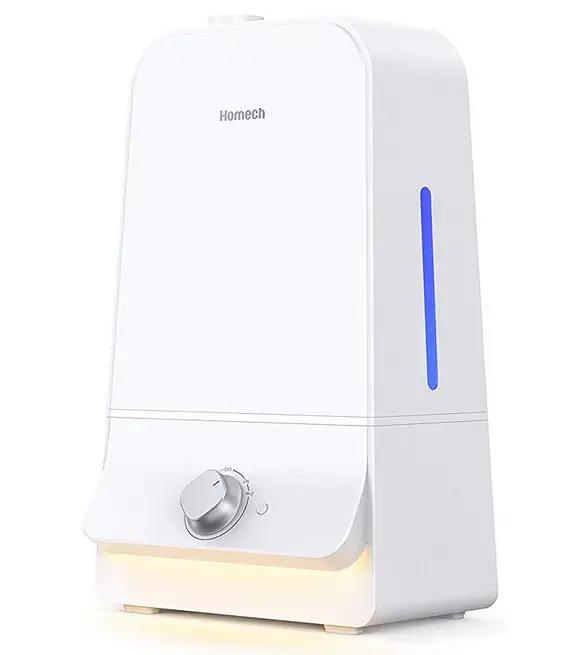
I needed a powerful yet silent humidifier that was bigger than the 1.2 gallons that the others recommend. This one is 1.59 Gallons.
Even though it’s advertised as being able to run for 100 hours straight, I have never managed that long. I can make it to 72 hours, which is good enough for me…Another factor was noise level. I was tempted to go with the Aircare Cool Mist Evaporative Model, but seeing the customer videos and the constant complaints of noise level, I had to decline.
Since I record videos and podcasts in my home office, the last thing I need is a loud hum from the background. My audiobooks would never sell with that rattle. I had to have absolute silence, or near that.
The nozzle on this one is turnable, so I can leave the humidifier in one place and just turn the nozzle to aim the mist at the orchids, and not my computer. And better yet—the mist reaches 1.3 meters high when turned on. I can sit this baby on the floor and it will reach the top shelf where my orchids are.
I absolutely love it.
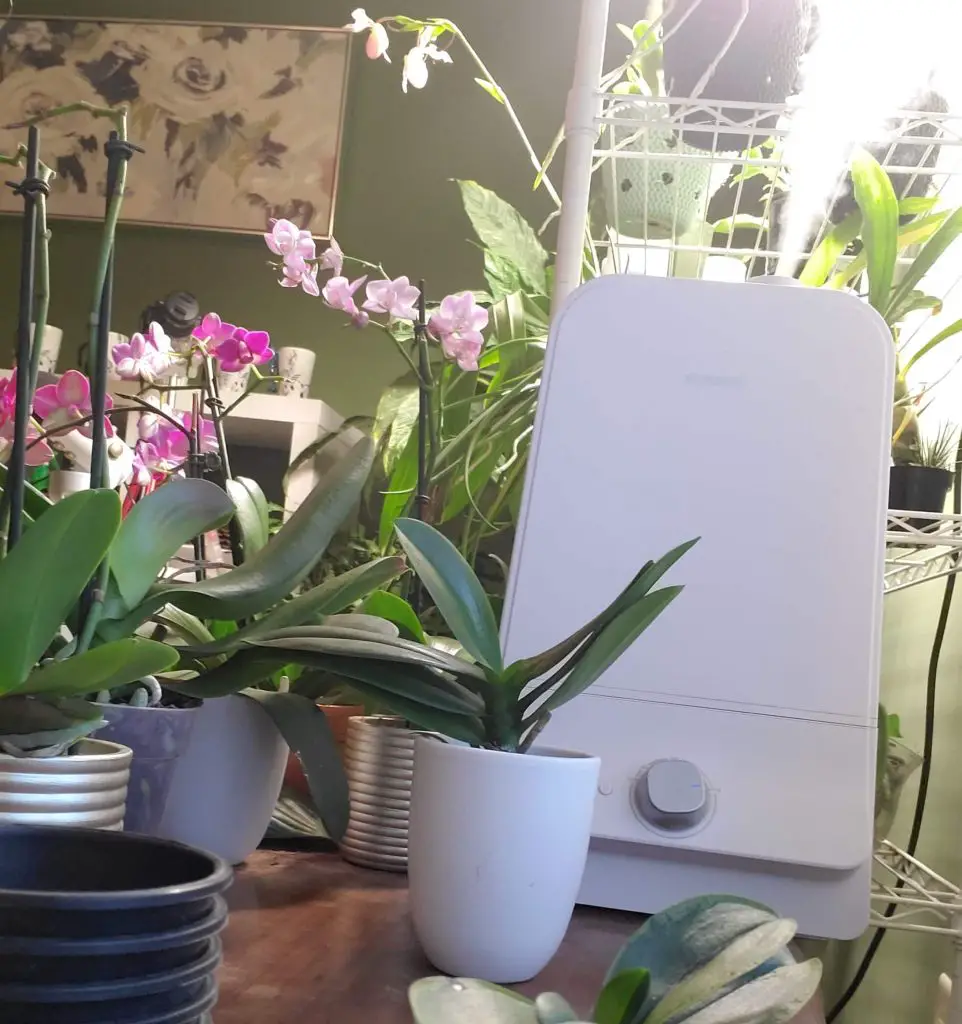
Another thing I really adore about this one is that there are no filter changes. I have a huge tendency to forget things, and I just know I’d go weeks without cleaning the filters, change in extra parts, etc. I still have to clean it regularly, as with all filters, but no additional products to buy, like wicks.
And yes, I hate to admit this one, but…design is important to me. I had to go with white, no matter what the product. This eliminated about 20% of the blue, transparent and black designs.
You see why I couldn’t recommend this one in the options above? My criteria are totally unique and I didn’t think most people had the same specifications in mind as I did.
Imagine the scene: “Why did you buy the humidifier?” asked a curious bystander. After a slight grin, I replied, “It was cute.”
Yeah, that just doesn’t cut it.
And the final push was it was on sale. Since I am on a budget, this guy was 33% off when I bought it. The normal price of around US$ 80 came down to around US$ 45.00. How can I pass up that offer?
In the end, you need to look around and find a humidifier that meets your orchid’s needs, your budget, and your lifestyle. All models are essentially “okay” and better than nothing. They will raise the humidity somewhat… You get what you pay for, and even then…Just saying, keep the receipts.
What I listed are suggestions of what is out on the market, but do your research and find a humidifier that suits your needs (and always, always keep the receipts.)
Happy Cultivating!


For those interested in reptiles, humidifiers are a normal part of the equipment to sustain a good environment for many species. I myself use such a humidifier (ultrasoniske), which so far has been uproblematic. Container holds approximately a gallon. I use water from a de-humidifier in our basement so no problems with deposits of any kind 😉
Converted to USD, it cost me around a hundred (product name is Habistat, but may not be available in the US), but i will not be able to humidify large areas (i.e. a whole room in your house/apartment)
Hi Morten Schjøtz-Pedersen,
Thank you so much for your comment. I have no experience with reptiles (only orchids) and your input was very valueable. I appreciate it, and am sure it helped others. 🙂
-Amanda
Amanda, I bought the exact humidifier you got! Did a lot of research and decided this met all my needs. Runs long enough on a gallon of distilled water that I don’t worry about it running dry. Plus it is so quiet you don’t even know it’s on, except you can see the mist, like that you can direct it. You are right also that it is attractive, some are so big and heavy looking. Hope my orchids love it as much as I do! Love your info! Thanks
Hi Diane,
What a great way to start my day reading a comment like yours! Thank you for that feedback! I appreciate it so much! 🙂
-Amanda
I grow Phalaenopsis and Cattleyas in a basement room with LED grow lights. (Cattleyas go outside during our KY summers. Our highs are in the upper 80-mid 90 range during the day and usually above 70 at night in summer) The temperature in the enclosed orchid room stays relatively stable around 70 degrees, plus or minus less than 5 degrees. I need more of a 10 temperature night drop for the Phalaenopsis to start a flower spike. I have considered an evaporative cooler to try to achieve the needed temperature drop at night. The evaporative cooler will also keep the humidity up. Do you think that this would this work to achieve the temperature drop?
Hi John,
I tempted to say absolutely, but then I don’t know how big the basement room is. If it a small room, then it would work like a charm. If the entire basement is covered in orchids, I’m not sure this would work. I wish I could tell you what would work in a bigger room, but I’ll have to check into that info first and get back with you. I grow all my orchids in a tiny room, so I don’t have that experience yet.
-Amanda
The basement room is 7 1/2′ X13′ with concrete floor and 3 painted white concrete walls and the 4th wall is drywall. LED gro lights are on a timer. It has no window. In the past 24 hours the temperature has ranged from 66-68 degrees. The relative humidity has ranged 58-66%. With the higher humidity here, I do now expect as much cooling effect as would be the experience in the drier Southwest. I have seen some evaporative coolers which use water and other use water with the option of also using freezer packs, which cold give the night time cooling.
Hi John,
Depending on the brand you purchase and how powerful it is, they can cool the room 5 – 7 degrees. This might be enough for the Phals to induce the spike, but I’m not sure. I’ve always heard of a 10 degree drop. Smaller evaporative humidifiers will have no effect on a room that big. Since there is no external air coming in (as in a draft from a window), then larger humidifiers might cool it initially (near the humidifier especially), but later stabilize the entire room. You said your temperature is 66-68. That is a little cool for the Cattleya, but a Phal can tolerate down to 55. I wouldn’t put the warm-growing Cattleya orchids near it though. These are just thoughts because there are so many types of brands and sizes that it’s really hard to say. A better idea would be to ask the company directly. They could give you more exact response than I can.
-Amanda
Is the humidifier you bought a top filler? That is a. ImportNt feature for me. I love all the great info you share on your website. It I so helpful and I thank you so much.
you so much
Hi Betty,
Sorry, but it’s not a top filler. You have to unscrew the bottom and then reattach it. In that sense, it’s a pain, but I still love it. 🙂
I have a small orchid cabinet – I’m a beginner with orchids. I would like your advice for humidifiers for small spaces. Thanks